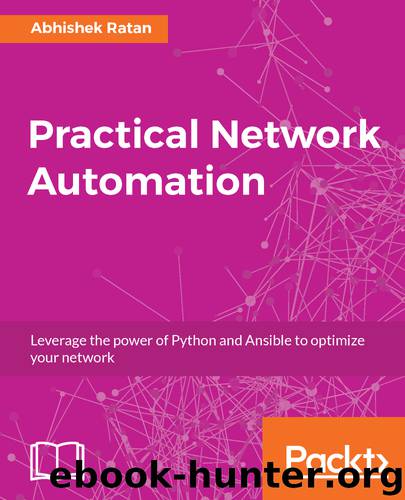Practical Network Automation by Abhishek Ratan

Author:Abhishek Ratan
Language: eng
Format: epub, mobi
Tags: COM043000 - COMPUTERS / Networking / General, COM088000 - COMPUTERS / System Administration / General, COM043040 - COMPUTERS / Networking / Network Protocols
Publisher: Packt Publishing
Published: 2018-04-12T12:24:31+00:00
Why create web-based scripts/frameworks?
A web framework is a collection of scripts, hosted on a web platform such as Internet Information Services (IIS) (on Windows) or Apache (on Linux), and calling the same script using front-end web-based languages such as HTML.
There are times when people ask why we want to migrate our current scripts or create scripts on a web framework. The answer is very simple. A web framework ensures that our scripts are used by multiple end users using just the browser. This gives the programmer the independence to code the script on their preferred platform (such as Windows or Linux), and people can use the scripts on their choice of browser. They don't need to understand how you have written the code, or what you are calling or using in the back-end, and of course, this ensures that you prevent your code from being directly visible to end users.
Let's say you have written a script that calls four or five libraries for specific tasks. There are general libraries, but as we have seen in previous chapters, some specific libraries need to be installed for the tasks. In this case, if you want to ensure that end users can execute your script, they need to install the same libraries on their machines. Also, they need to be running a Python environment on their machines, without which the scripts would not run. So, to run a small script of let's say five lines, users need to customize their environment by installing Python, installing libraries, and so on.
This might not be feasible for a lot of users because of restrictions on their machines (such as installation not being allowed), so even though there is a requirement to run the scripts for those users, they would be unable to use the scripts, which would effectively lower efficiency. But the same users, if given the option, could easily open the browser of their choice and use those scripts like opening any other web page, which would ensure that our scripts bring greater efficiency to the tasks.
Download
Practical Network Automation by Abhishek Ratan.mobi
This site does not store any files on its server. We only index and link to content provided by other sites. Please contact the content providers to delete copyright contents if any and email us, we'll remove relevant links or contents immediately.
Sass and Compass in Action by Wynn Netherland Nathan Weizenbaum Chris Eppstein Brandon Mathis(7837)
Grails in Action by Glen Smith Peter Ledbrook(7771)
Azure Containers Explained by Wesley Haakman & Richard Hooper(6921)
Configuring Windows Server Hybrid Advanced Services Exam Ref AZ-801 by Chris Gill(6912)
Running Windows Containers on AWS by Marcio Morales(6448)
Kotlin in Action by Dmitry Jemerov(5156)
Microsoft 365 Identity and Services Exam Guide MS-100 by Aaron Guilmette(5113)
Microsoft Cybersecurity Architect Exam Ref SC-100 by Dwayne Natwick(4698)
Combating Crime on the Dark Web by Nearchos Nearchou(4686)
Management Strategies for the Cloud Revolution: How Cloud Computing Is Transforming Business and Why You Can't Afford to Be Left Behind by Charles Babcock(4440)
The Ruby Workshop by Akshat Paul Peter Philips Dániel Szabó and Cheyne Wallace(4376)
The Age of Surveillance Capitalism by Shoshana Zuboff(3999)
Python for Security and Networking - Third Edition by José Manuel Ortega(3931)
Learn Wireshark by Lisa Bock(3610)
The Ultimate Docker Container Book by Schenker Gabriel N.;(3596)
Learn Windows PowerShell in a Month of Lunches by Don Jones(3536)
Mastering Python for Networking and Security by José Manuel Ortega(3381)
Mastering Azure Security by Mustafa Toroman and Tom Janetscheck(3370)
Blockchain Basics by Daniel Drescher(3339)
